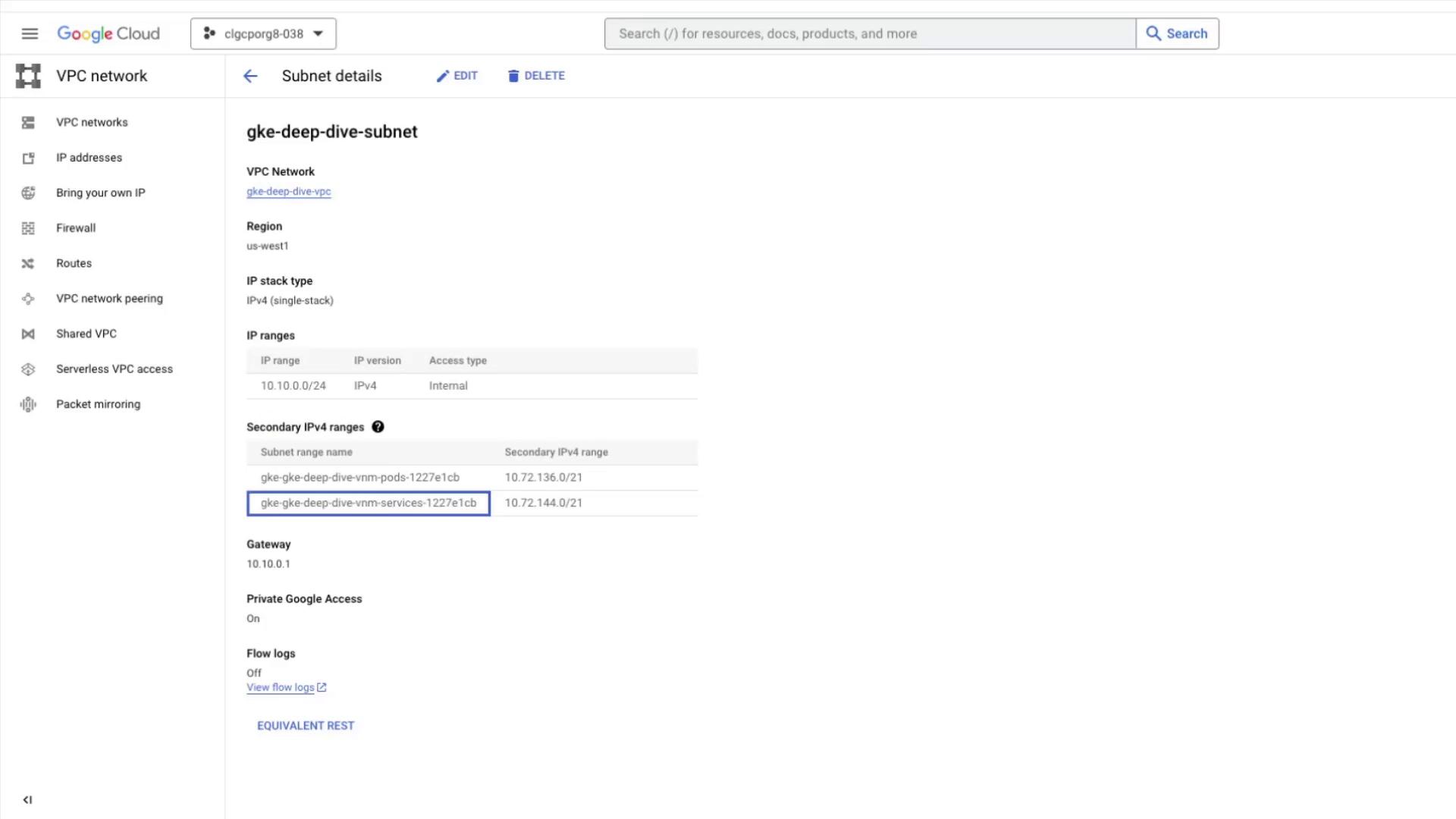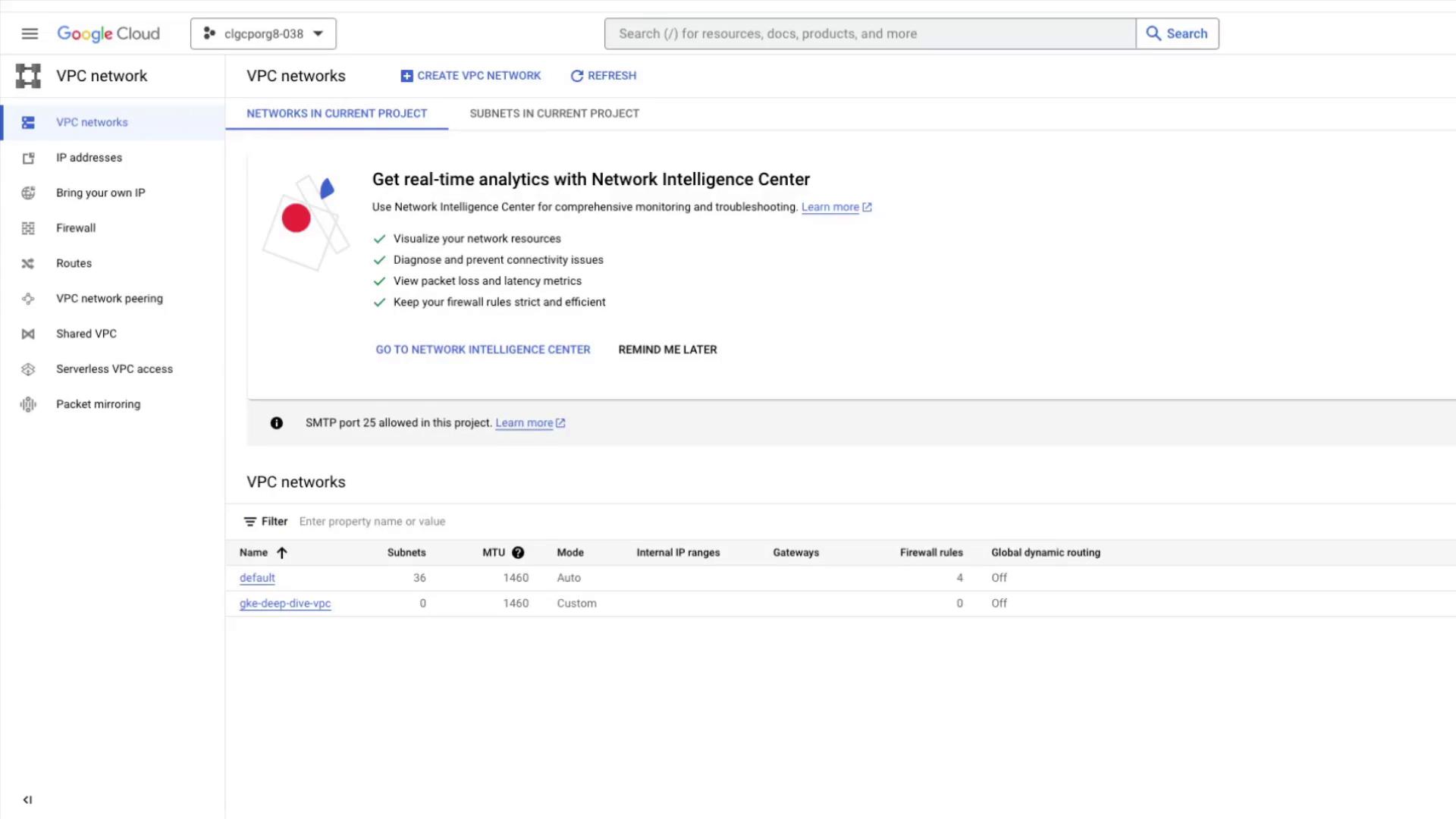GKE - Google Kubernetes Engine
Networking for GKE clusters
Demo Create a VPC native cluster and configure max allowed pods
In this tutorial, you’ll learn how to provision a VPC-native Google Kubernetes Engine (GKE) cluster with IP aliasing and manage its secondary IP ranges. We’ll walk through:
| Step | Description |
|---|---|
| 1 | Set your Compute Zone |
| 2 | Create a custom VPC |
| 3 | Add a regional subnet |
| 4 | Launch an IP-alias (VPC-native) GKE cluster |
| 5 | Verify the secondary IP ranges |
| 6 | Clean up all resources |
1. Set the Compute Zone
Configure your default compute zone to us-west1-a (or your preferred region).
gcloud config set compute/zone us-west1-a
2. Create a Custom VPC
Create a VPC in custom subnet mode so you can define your own IP ranges.
gcloud compute networks create gke-deep-dive-vpc \
--subnet-mode=custom
In the Google Cloud Console, navigate to VPC network → VPC networks. You should see gke-deep-dive-vpc listed, but no subnets yet.
3. Add a Regional Subnet
Define a subnet in us-west1 with a /24 CIDR block.
gcloud compute networks subnets create gke-deep-dive-subnet \
--network=gke-deep-dive-vpc \
--range=10.10.0.0/24 \
--region=us-west1
Note
VPC networks are global, whereas subnets are regional. Choose the region that best suits your workload.
Refresh VPC networks → Subnets in the Console to confirm the gke-deep-dive-subnet (10.10.0.0/24) appears under your VPC.
4. Launch an IP-Alias (VPC-native) GKE Cluster
Use IP aliasing to allocate two secondary IP ranges—one for Pods and one for Services.
gcloud container clusters create gke-dive-vpc-native \
--zone=us-west1-a \
--num-nodes=1 \
--disk-type=pd-standard \
--disk-size=10 \
--enable-ip-alias \
--network=gke-deep-dive-vpc \
--subnetwork=gke-deep-dive-subnet \
--cluster-secondary-range-name=pods-range \
--services-secondary-range-name=services-range \
--cluster-ipv4-cidr=/21 \
--services-ipv4-cidr=/21
| Flag | Purpose |
|---|---|
--enable-ip-alias | Enable VPC-native IP aliasing |
--cluster-secondary-range-name | Name for the Pods’ secondary IP range |
--services-secondary-range-name | Name for the Services’ secondary IP range |
/21 CIDR | Allocates a block with ~2048 IPs for each range |
Cluster provisioning can take several minutes.
5. Verify Secondary Ranges
Console View
In the Cloud Console, open VPC networks → Subnets and select gke-deep-dive-subnet. You should see two new secondary IP ranges:

CLI Verification
Describe the cluster’s IP allocation policy:
gcloud container clusters describe gke-dive-vpc-native \
--zone=us-west1-a \
--format="yaml(ipAllocationPolicy)"
Look for these fields in the output:
clusterIpv4CidrservicesIpv4CidrclusterSecondaryRangeNameservicesSecondaryRangeName
6. Clean Up Resources
Delete the GKE Cluster
gcloud container clusters delete gke-dive-vpc-native \
--zone=us-west1-a --quiet
Secondary ranges are automatically detached from gke-deep-dive-subnet upon cluster deletion.
Remove Subnet and VPC
gcloud compute networks subnets delete gke-deep-dive-subnet \
--region=us-west1 --quiet
gcloud compute networks delete gke-deep-dive-vpc --quiet
Back in the Console, verify that only the default VPC remains:

Warning
Resource deletion is irreversible. Ensure no critical workloads are running before you clean up.
Links and References
Watch Video
Watch video content